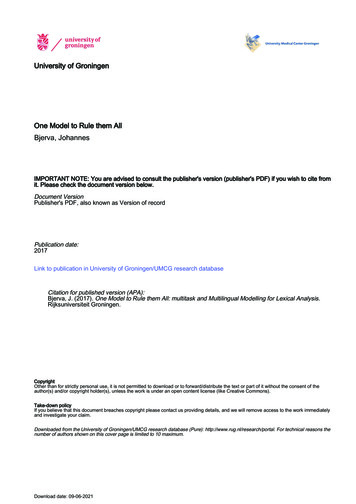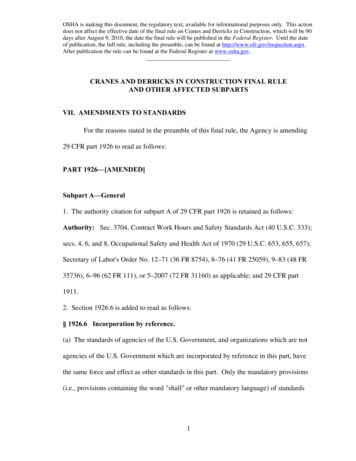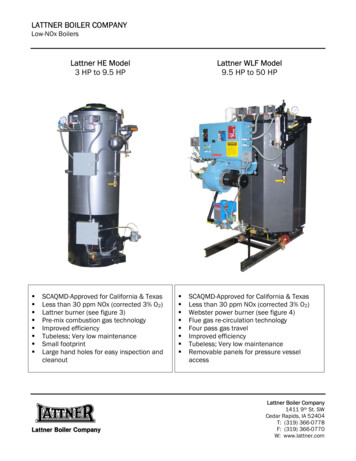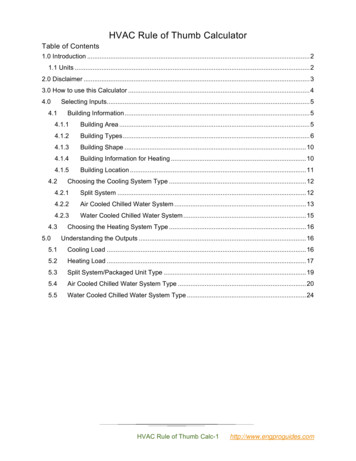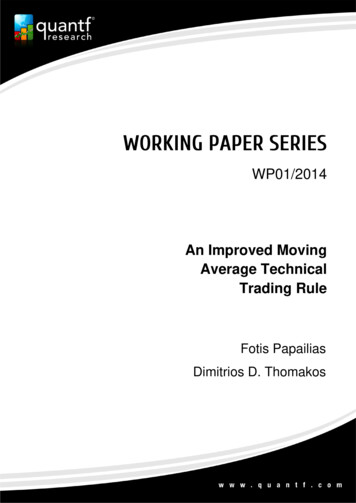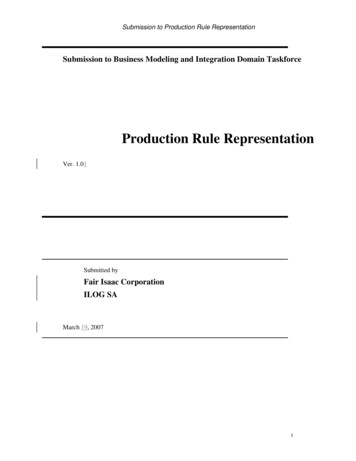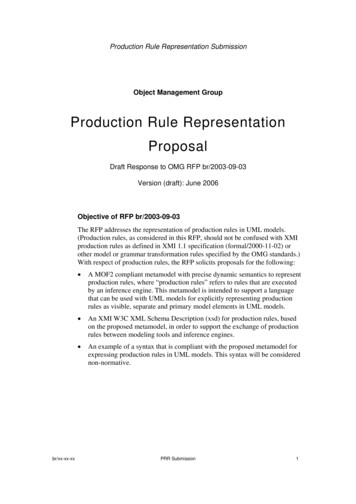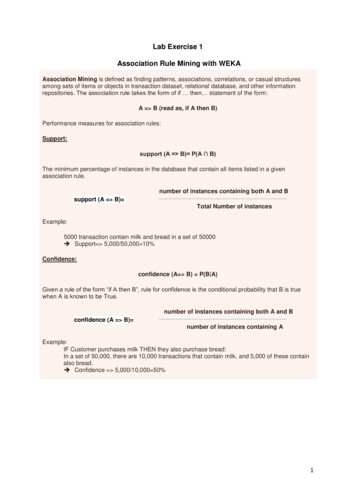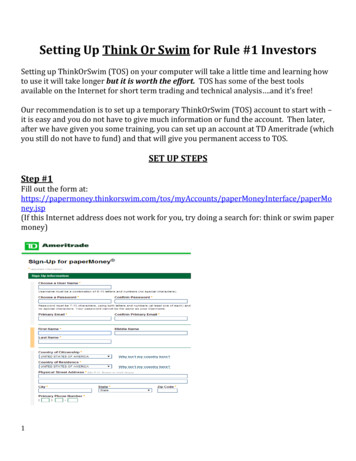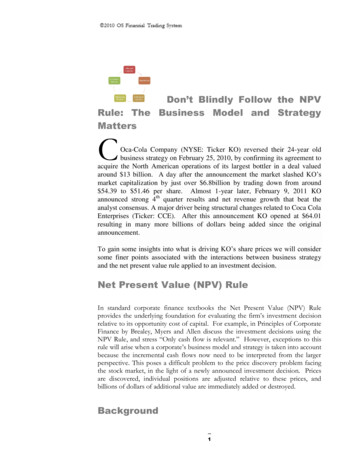
Transcription
Don’t Blindly Follow the NPVRule: The Business Model and StrategyMattersCOca-Cola Company (NYSE: Ticker KO) reversed their 24-year oldbusiness strategy on February 25, 2010, by confirming its agreement toacquire the North American operations of its largest bottler in a deal valuedaround 13 billion. A day after the announcement the market slashed KO’smarket capitalization by just over 6.8billion by trading down from around 54.39 to 51.46 per share. Almost 1-year later, February 9, 2011 KOannounced strong 4th quarter results and net revenue growth that beat theanalyst consensus. A major driver being structural changes related to Coca ColaEnterprises (Ticker: CCE). After this announcement KO opened at 64.01resulting in many more billions of dollars being added since the originalannouncement.To gain some insights into what is driving KO’s share prices we will considersome finer points associated with the interactions between business strategyand the net present value rule applied to an investment decision.Net Present Value (NPV) RuleIn standard corporate finance textbooks the Net Present Value (NPV) Ruleprovides the underlying foundation for evaluating the firm’s investment decisionrelative to its opportunity cost of capital. For example, in Principles of CorporateFinance by Brealey, Myers and Allen discuss the investment decisions using theNPV Rule, and stress “Only cash flow is relevant.” However, exceptions to thisrule will arise when a corporate’s business model and strategy is taken into accountbecause the incremental cash flows now need to be interpreted from the largerperspective. This poses a difficult problem to the price discovery problem facingthe stock market, in the light of a newly announced investment decision. Pricesare discovered, individual positions are adjusted relative to these prices, andbillions of dollars of additional value are immediately added or destroyed.Background1
In the current case the Coca-Cola company made an investment decisionannouncement that arguably has short term negative cash flow implications butlonger term strategic implications. For the case of Coca-Cola the initial responsewas consistent with applying the NPV rule followed by a re-evaluation phaseUnder the terms of what the two companies called a “substantiallycashless” deal, Coke will take over the North American operations of thebottler, Coca-Cola Enterprises. Coca-Cola Enterprises, or C.C.E., would thenacquire Coke’s bottling operations in Norway and Sweden, becoming aEuropean-focused producer and distributor of Coke products. It will alsohave the right to buy Coke’s 83 percent stake in its German bottlingoperations within 18 months to 36 months after the deal’s closing. Afterthe deal’s closing, expected in the fourth quarter, Coke will own about 90percent of its North American bottling operations.In the deal, valued at more than 13 billion, Coke will give up its 34 percentstake in C.C.E., valued at 3.4 billion, and assume about 9.5 billion of C.C.E.debts and other obligations.”(NY Times By MICHAEL J. de la MERCED) February 25, 2010.The above announcement reverses a 24-year old strategy for Coca-Colaand has both short and long term implications for both KO’s investmentand financing decisions which had significant valuation implications.NPV Rule and the Stock Price ReactionAround the time of this announcement KO shares declined relative to PEPstock.Stock Prices: Announcement Date Feb 25, 59.8961.2862.09That is, KO’s market capitalization reduced by about 6.8 billion byannouncing a deal that was valued around 13 billion. From a NPV ruleinterpretation this was a negative 6.2 billion NPV project relative to animplied 13 billion outlay.This market reaction reflects the relative weaker financials for CCE versusKO:2
KO's OperatingIncomeCCE's 07,252.006,308.006,085.001,470.00 -1,495.001,431.001,518.00 -6,299.00Interpretation From the Perspective of KO’sBusiness Model and StrategyFirst, consider applying Porter’s Value Chain to cover Coca Cola pre and postthis announcement. We will keep this chain simple to provide an overview ofKO’s business model. Briefly a firm’s business model describes how it plans tocreate value from the set of economic resources under it’s control. For thecase of KO it’s business model requires producing and distributing syrups andfor bottling non-alcoholic beverages. KO also aggressively markets it’s nonalcoholic beverages under its widely recognized “Coca-Cola” logo. It is notedthat this is reinforced in KO’s 10-K Item 1 where they emphasize being: “theworld's largest manufacturer, distributor and marketer of concentrates andsyrups used to produce nonalcoholic beverages.” However, post theannouncement KO’s Operations, Outbound Logistics and Marketing & Salesare planned to undergo significant change. Operations will include not onlymanufacturing syrups but bottling. This will serve to align Coca-Cola’sbusiness model more closely with the parts of PepsiCo’s business modeldescribed in their 10-K under the section titled “Our Distribution Networks.”(see appendix).Coca-Cola’s Marketing & Sales will also change in two significant ways. CocaCola will have a lot more flexibility over bottling/labels/local pricingpromotions. They will also be able to exploit Supply Chain Management (SCM)to a much greater degree than prior to the announcement. This is becausefirst, KO gains control over an important source of real time information – thatis how their products are moving in different parts of their North Americanoperations. The significance of this point was recently demonstrated by thefact that on 9/27/2010 it was announced that the FTC put conditions on theacquisition (in response to a complaint filed by the Dr Pepper Snapple Group)and in particular that Coca-Cola agreed to restrictions on its access tocompetitively sensitive information of Dr Pepper Snapple Group Subsidiary.This involves creating a “firewall” to restrict access to Dr Pepper information.Second, KO will be better able to integrate their inbound logistics andoutbound logistics with their suppliers and retailers. These last points haveimplications for the two additional links Customer Service and Inbound3
Logistics. In other words every link is impacted by the announcement whichshould enable KO to squeeze additional efficiencies out of their system bymore efficiently implementing SCM practices.KO’s traditional business strategy involved choosing not to perform bottlingactivities that are currently performed by its rival PepsiCo.Clearly post the announcement KO has announced it’s intention to shift to astrategy that actively embraces these activities. Post the announcement theirstrategy would appear that KO is better positioning itself to compete withPepsiCo along this dimension in arguably similar ways.From theannouncement it would appear that KO is going to attempt to differentiate byaggressively embracing SCM principles (see Chapter 1 Valuation Tutor) toengineer some significant longer term cost savings. For example, KO willcontrol 72% of the US markets and 100% of Canada. This will generate richinformation which already drew the immediate attention of Dr PepperSnapple with respect to their own business. In the report KO estimates it canachieve around 350 million in cost savings over the next four years and thiswas later revised up. KO will presumably attempt to separate itself byexploiting information as a source of value as opposed to a support activity,that is exploit activities in “MarketSpace” as well as the “MarketPlace” asdiscussed in Chapter 1 of Valuation Tutor.It is clear from the PepsiCo description of CSD (Carbonated Soft Drinks) thatKO will initially have an informational advantage to work with given it is themarket leader in this area. This is an intangible asset that is a source of value.4
In addition the SCM principles will enable KO to exploit efficiencies on the costside. As a result, to communicate their business strategy requires adopting amultidimensional approach for which the balanced scorecard is relevant.The balanced scorecard as discussed in Chapter 1 of Valuation tutor, providesa method for communicating business strategy in terms of four importantdimensions:Financial, Customer, Process and Learning & Growth. Financial Perspective focuses upon bottom line ratios – ROE (Return onShareholder’s Equity), ROA (Return on Assets), EPS – Earnings pershare, FCF – Free Cash Flow and Stock Price ---this perspective mayexhibit short run adverse effects as the deal is a cash and debt deal.The company has suggested that it will be “accretive” to dilutedearnings per share in 2012, in other words the positive impact is notlikely to kick in until 2012. This suggests the short term impact will benegative. In addition, the KO’s financial leverage will increase with theadditional debt. So likely impact on the financial perspective isnegative short run and positive in longer term. Customer Perspective focuses upon Sales Revenue. This should bepositive because KO is taking over local marketing to grocery storesetc.,. In combination with its control over bottling it can be a lot moreresponsive to change conditions in the US and Canada across regionalareas. This combined with the more efficient utilization of information5
by SCM should allow KO to compete more aggressively with PEP at thelocal supermarket level. So impact here should be positive soon afterthey have implemented the SCM. Again this is likely to spread out overfour years given the cost efficiencies will take four years to materialize. Process focuses upon the cost side and efficiency ratios e.g., inventoryturnover, asset utilization, accounts receivable turnover. Initially thesetypes of ratios will be adversely affected until the cost efficiencies fromimplementing SCM kick in. Learning and Growth focuses upon human capital and growth behaviorThis is likely to have the least noticeable effect. However, by havingemployees work through all parts of the business will permit someefficiencies to be extracted in the longer term. Growth will bepositively impacted in the longer term by exploiting the sales flexibilityand operational flexibility.The acquisition will have an immediate impact will be on the financialdimension and probably adverse. However, if the impact upon the other twodimensions Operations (cost efficiencies) and Customer (Revenue Growth)evolve as expected the initial negative impact should evolve into a positiveimpact. The benefits are expected as early as 2012 by the company.Overall the strategy appears to be sound especially if they exploit the potentialefficiencies available from SCM. A primary potential dividend from this is thatKO has the chance of controlling information in real time regarding productmovement, labeling preferences and other properties that influence localsupply and demand. This information is exploitable via SCM and theirextended value chain to squeeze out cost efficiencies and exploit revenueopportunities. So overall the two dimensions Customer and Process are likelyto feed into stronger ROE numbers in 2012 and beyond.The stock market performance between KO and PEP for 2010 reinforced thebusiness strategy implications as KO pretty much closed the gap with PEP byyear end, even though there was an initial decline after the an announcementof the investment decision in February.6
KO vrs PEP 2010 Daily Price Data80706050403020100KO 2010PEP CloseIn a subsequent blog we will apply Valuation tutor to perform the ratio andrelated economic analysis of KO’s investment decision including a comparisonto PEP especially as the 2010 figures become available.ConclusionsThe investment decision clearly has first order importance upon a stock’s priceand therefore when a major new announcement that reverses past decisionsis made deserves close scrutiny. For the case of KO the market’s initialresponse appeared to follow the NPV rule that only cash flow matters relativeto the stock’s opportunity cost of capital. This was because the operatingresults from KO were a lot stronger than the operating results for CCE.However, when viewed from the perspective of KO’s business model andstrategy there were a number of synergistic effects, one of which attractedFTC attention relative to a competitor. As a result, the decision when viewedin this broader context looks to be very sound. In addition, as the marketsreceives reinforcement of this billions of dollars of shareholder value are beingadded back in the form of higher stock prices.A second, important conclusion to draw from this case is that to be able toperform financial statement analysis effectively requires understanding thestock’s business model and business strategy. In the Valuation Tutor weillustrate this important point and we will further reinforce this with the futureCoca-Cola blog.7
For the case of Coca-Cola the initial response was consistent with applying the NPV rule followed by a re-evaluation phase Under the terms of what the two companies called a “substantially cashless” deal, Coke will take over the North American operations of the bottler, Coca-Cola Enterprises. Coca-Cola Enterprises, or C.C.E., would then acquire Coke’s bottling operations in Norway and .
